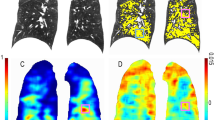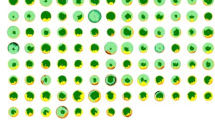Abstract
Objectives
To investigate whether morphometric complexity in the lung can predict survival and act as a new prognostic marker in patients with chronic obstructive pulmonary disease (COPD).
Methods
COPD (n = 302) patients were retrospectively reviewed. All patients underwent volumetric computed tomography and pulmonary function tests at enrollment (2005–2015). For complexity analysis, we applied power law exponent of the emphysema size distribution (Dsize) as well as box-counting fractal dimension (Dbox3D) analysis. Patients’ survival at February 2017 was ascertained. Univariate and multivariate Cox proportional hazards analyses were performed, and prediction performances of various combinatorial models were compared.
Results
Patients were 66 ± 6 years old, had 41 ± 28 pack-years’ smoking history and variable GOLD stages (n = 20, 153, 108 and 21 in stages I−IV). The median follow-up time was 6.1 years (range: 0.2−11.6 years). Sixty-three patients (20.9%) died, of whom 35 died of lung-related causes. In univariate Cox analysis, lower Dsize and Dbox3D were significantly associated with both all-cause and lung-related mortality (both p < 0.001). In multivariate analysis, the backward elimination method demonstrated that Dbox3D, along with age and the BODE index, was an independent predictor of survival (p = 0.014; HR, 2.08; 95% CI, 1.16–3.71). The contributions of Dsize and Dbox3D to the combinatorial survival model were comparable with those of the emphysema index and lung-diffusing capacity.
Conclusions
Low morphometric complexity in the lung is a predictor of survival in patients with COPD.
Key Points
• A newly suggested method for quantifying lung morphometric complexity is feasible.
• Morphometric complexity measured on chest CT images predicts COPD patients’ survival.
• Complexity, diffusing capacity and emphysema index contribute similarly to the survival model.



Similar content being viewed by others
Abbreviations
- BODE:
-
Integrated COPD prognostic index of four factors: the body mass index (B), the degree of airflow obstruction (O) and dyspnoea (D) and exercise capacity (E), measured by the 6-min walk test
- cDLCO%:
-
Percentage of diffusing capacity of the lung for carbon monoxide corrected by haemoglobin to the expected value
- CI:
-
Confidence interval
- C-index:
-
Concordance index
- Dbox3D :
-
Box-counting fractal dimension of the lung parenchyma in full-3D
- Dsize :
-
Power law exponent of the size distribution of emphysema clusters
- EI%:
-
Percentage of the lung volume occupied by emphysema
- HR:
-
Hazard ratio
- KOLD:
-
Korean obstructive lung disease
- LAA:
-
Low attenuation area
- PLE:
-
Power law exponent
References
Labaki WW, Martinez CH, Martinez FJ et al (2017) The role of chest computed tomography in the evaluation and management of the patient with COPD. Am J Respir Crit Care Med 196:1372–1379
Vogelmeier CF, Criner GJ, Martinez FJ et al (2017) Global strategy for the diagnosis, management, and prevention of chronic obstructive lung disease 2017 report: GOLD executive summary (vol 53, pg 128, 2017). Arch Bronconeumol 53:411–412
Anthonisen NR, Wright EC, Hodgkin JE, Hopewell PC, Levin DC, Stevens PM (1986) Prognosis in chronic obstructive pulmonary-disease. Am Rev Respir Dis 133:14–20
Celli BR, Cote CG, Marin JM et al (2004) The body-mass index, airflow obstruction, dyspnea, and exercise capacity index in chronic obstructive pulmonary disease. N Engl J Med 350:1005–1012
Dawkins PA, Dowson LJ, Guest PJ, Stockley RA (2003) Predictors of mortality in alpha(1)-antitrypsin deficiency. Thorax 58:1020–1026
Haruna A, Muro S, Nakano Y et al (2010) CT scan findings of emphysema predict mortality in COPD. Chest 138:635–640
Kessler R, Faller M, Fourgaut G, Mennecier B, Weitzenblum E (1999) Predictive factors of hospitalization for acute exacerbation in a series of 64 patients with chronic obstructive pulmonary disease. Am J Respir Crit Care Med 159:158–164
Martinez FJ, Foster G, Curtis JL et al (2006) Predictors of mortality in patients with emphysema and severe airflow obstruction. Am J Respir Crit Care Med 173:1326–1334
Tanabe N, Muro S, Sato S et al (2012) Longitudinal study of spatially heterogeneous emphysema progression in current smokers with chronic obstructive pulmonary disease. PLoS One 7:e44993
Kirby M, Tanabe N, Tan WC et al (2018) Total airway count on computed tomography and the risk of chronic obstructive pulmonary disease progression findings from a population-based study. Am J Respir Crit Care Med 197:56–65
Mishima M, Hirai T, Itoh H et al (1999) Complexity of terminal airspace geometry assessed by lung computed tomography in normal subjects and patients with chronic obstructive pulmonary disease. Proc Natl Acad Sci U S A 96:8829–8834
Grassberger P (1983) On the fractal dimension of the henon attractor. Phys Lett A 97:224–226
Ott E (1993) Chaos in dynamical systems. Cambridge University Press, Cambridge
Weibel ER (1991) Fractal geometry - a design principle for living organisms. Am J Physiol 261:L361–L369
Weibel ER (2009) What makes a good lung? The morphometric basis of lung function. Swiss Med Wkly 139:375–386
Mandelbrot B (1983) The fractal geometry of nature. Freeman, New York
Weibel ER (2013) It takes more than cells to make a good lung. Am J Respir Crit Care Med 187:342–346
Vuidel G PFaCT Fractal analysis software. research team "Mobilities, city and transport" of the research centre ThéMA., France. Available via http://www.fractalyse.org/. Accessed 31 July 2017
Gilliard N, Pappert D, Spragg RG (1995) Fractal analysis of surfactant deposition in rabbit lungs. J Appl Physiol 78:862–866
Glenny R, Robertson HT (1991) Spatial correlation - a corollary of fractal pulmonary perfusion. FASEB J 5:A404–A404
Glenny RW, Robertson HT (1990) Fractal properties of pulmonary blood-flow - characterization of spatial heterogeneity. J Appl Physiol 69:532–545
Glenny RW, Robertson HT (1991) Fractal modeling of pulmonary blood-flow heterogeneity. J Appl Physiol 70:1024–1030
Glenny RW, Robertson HT, Yamashiro S, Bassingthwaighte JB (1991) Applications of fractal analysis to physiology. J Appl Physiol 70:2351–2367
Horsfield K (1990) Diameters, generations, and orders of branches in the bronchial tree. J Appl Physiol 68:1089–1097
Park TS, Lee JS, Seo JB et al (2014) Study design and outcomes of korean obstructive lung disease (Kold) cohort study. Tuberc Respir Dis 76:169–174
Hwang J, Lee M, Lee SM et al (2016) A size-based emphysema severity index: robust to the breath-hold-level variations and correlated with clinical parameters. Int J Chron Obstruct Pulmon Dis 11:1835–1841
Lee M KN, Lee SM, Seo JB, Oh SY (2015) Size-based emphysema cluster analysis on low attenuation area in 3D volumetric CT: comparison with pulmonary functional testProc SPIE 9417, Medical Imaging 2015: Biomedical Applications in Molecular, Structural, and Functional Imaging, Orlando, FL, USA, p 91472V
Cox DR (1972) Regression models and life-tables. J Royal Stat Soc B 34:187–220
Wickham H, Francois R, Henry L, Muller K (2017) dplyr: a grammar of data manipulation. R package version 0.7.3. Available via https://CRAN.R-project.org/package=dplyr
Therneau TM (2015) A package for survival analysis in S. Available via https://CRAN.R-project.org/package=survival
Saha-Chaudhuri PJ, Hapb P (2013) survivalROC: Time-dependent ROC curve estimation from censored survival data. Available via https://CRAN.R-project.org/package=survivalROC
Bhatt SP, Bodduluri S, Hoffman EA et al (2017) Computed tomography measure of lung at risk and lung function decline in chronic obstructive pulmonary disease. Am J Respir Crit Care Med 196:569–576
Parr DG (2017) Quantifying the lung at risk in chronic obstructive pulmonary disease does emphysema beget emphysema? Am J Respir Crit Care Med 196:535–536
Ley B, Flicker BM, Hartman TE et al (2014) Idiopathic pulmonary fibrosis: CT and risk of death. Radiology 273:570–579
MacIntyre N, Crapo RO, Viegi G et al (2005) Standardisation of the single-breath determination of carbon monoxide uptake in the lung. Eur Respir J 26:720–735
Acknowledgements
Dain Eun designed the schematic representations in Fig. 1.
Funding
This study has received funding by the Basic Science Research Program through the National Research Foundation of Korea (NRF-2016R1D1A1A02937317).
Author information
Authors and Affiliations
Corresponding authors
Ethics declarations
Guarantor
The scientific guarantor of this publication is Namkug Kim.
Conflict of interest
The authors of this article declare no relationships with any companies whose products or services may be related to the subject matter of the article.
Statistics and biometry
Nayoung Kim kindly provided statistical advice for this manuscript.
Informed consent
Written informed consent was obtained from all subjects (patients) in this study.
Ethical approval
Institutional Review Board approval was obtained.
Study subjects or cohorts overlap
The study subjects are from Korean Obstructive Lung Disease (KOLD) cohort. There are 54 articles by KOLD study group, and more than 100 articles stating the exact phrase “Korean Obstructive Lung Disease”. We suppose that many of those would have a substantial extent of subject overlaps with our current study. However, the key point of our current study was to suggest new imaging biomarkers, and those biomarkers, Dbox and Dsize, have never been measured for any of the subjects before, making our current finding novel.
Methodology
• retrospective
• diagnostic or prognostic study
• multicentre study
Electronic supplementary material
ESM 1
(DOCX 147 kb)
Rights and permissions
About this article
Cite this article
Hwang, J., Oh, YM., Lee, M. et al. Low morphometric complexity of emphysematous lesions predicts survival in chronic obstructive pulmonary disease patients. Eur Radiol 29, 176–185 (2019). https://doi.org/10.1007/s00330-018-5551-7
Received:
Revised:
Accepted:
Published:
Issue Date:
DOI: https://doi.org/10.1007/s00330-018-5551-7




